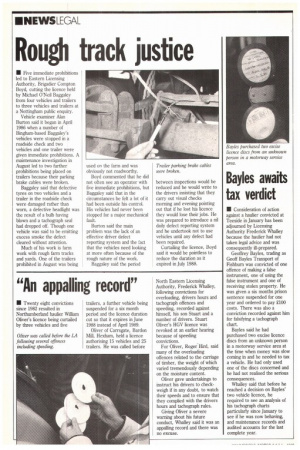Rough track justice
Page 26

If you've noticed an error in this article please click here to report it so we can fix it.
• Five immediate prohibitions led to Eastern Licensing Authority, Brigadier Compton Boyd, cutting the licence held by Michael O'Neil Baggaley from four vehicles and trailers to three vehicles and trailers at a Nottingham public enquiry.
Vehicle examiner Alan Burton said it began in April 1986 when a number of Bingham-based Baggaley's vehicles were stopped in a roadside check and two vehicles and one trailer were given immediate prohibitions. A maintenance investigation in August led to two further prohibitions being placed on trailers because their parking brake cables were broken.
Baggaley said that defective tyres on two vehicles and a trailer in the roadside check were damaged rather than worn, a defective headlight was the result of a bulb having blown and a tachograph seal had dropped off. Though one vehicle was said to be emitting excess smoke the defect cleared without attention.
Much of his work is farm work with rough farm tracks and yards. One of the trailers prohibited in August was being used on the farm and was obviously not roadworthy.
Boyd commented that he did not often see an operator with five immediate prohibitions, but Baggaley said that in the circumstances he felt a lot of it had been outside his control. His vehicles had never been stopped for a major mechanical fault.
Burton said the main problem was the lack of an effective driver defect reporting system and the fact that the vehicles need looking at more often because of the rough nature of the work.
Baggaley said the period between inspections would be reduced and he would write to the drivers insisting that they carry out visual checks morning and evening pointing out that if he lost his licence they would lose their jobs. He was prepared to introduce a nil daily defect reporting system and he undertook not to use vehicles until any defect had been repaired.
Curtailing the licence, Boyd said it would be pointless to reduce the duration as it expired in July 1988.




















































































